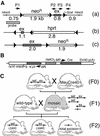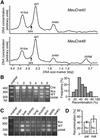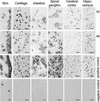Cre-mediated germline mosaicism: a new transgenic mouse for the selective removal of residual markers from tri-lox conditional alleles
- PMID: 12595570
- PMCID: PMC149843
- DOI: 10.1093/nar/gng021
Cre-mediated germline mosaicism: a new transgenic mouse for the selective removal of residual markers from tri-lox conditional alleles
Abstract
The binary Cre-lox conditional knockout system requires an essential part of the target gene to be flanked by loxP sites, enabling excision in vivo upon Cre expression. LoxP sites are introduced by homologous recombination, together with a selectable marker. However, this marker can disturb gene expression and should be removed. The marker is therefore often prepared with a third, flanking loxP site (tri-lox construct), facilitating its selective removal by partial Cre-lox recombination. We have shown that this excision can be achieved in vivo in the germline using EIIaCre transgenic mice, and have described the advantages of in vivo over in vitro removal. We show here that MeuCre40, a new transgenic mouse, more reliably and reproducibly generates an optimal partial mosaic Cre-lox recombination pattern in the early embryo. This mosaicism was transmitted to the germline and to many other tissues. Alleles with partial deletions, in particular floxed alleles from which the selectable marker was removed, were readily recovered in the next generation, after segregation from the transgene. Segregation via paternal or maternal transmission led to successful recovery of the alleles of interest. We also obtained total deletion of the floxed regions in the same experiment, making this transgene a polyvalent Cre-lox tool. We rigorously tested the ability of MeuCre40 to solve tri-lox problems, by using it for the in vivo removal of neo(R)- and hprt-expression cassettes from three different tri-lox mutants.
Figures




Similar articles
-
Cre-mediated germline mosaicism: a method allowing rapid generation of several alleles of a target gene.Nucleic Acids Res. 2000 Nov 1;28(21):E92. doi: 10.1093/nar/28.21.e92. Nucleic Acids Res. 2000. PMID: 11058142 Free PMC article.
-
Spontaneous ectopic recombination in cell-type-specific Cre mice removes loxP-flanked marker cassettes in vivo.Genesis. 2004 Apr;38(4):159-65. doi: 10.1002/gene.20011. Genesis. 2004. PMID: 15083516
-
Balancer-Cre transgenic mouse germ cells direct the incomplete resolution of a tri-loxP-targeted Cyp1a1 allele, producing a conditional knockout allele.Biochem Biophys Res Commun. 2003 Dec 12;312(2):494-9. doi: 10.1016/j.bbrc.2003.10.145. Biochem Biophys Res Commun. 2003. PMID: 14637164
-
Detecting and Avoiding Problems When Using the Cre-lox System.Trends Genet. 2018 May;34(5):333-340. doi: 10.1016/j.tig.2017.12.008. Epub 2018 Jan 11. Trends Genet. 2018. PMID: 29336844 Free PMC article. Review.
-
[Progress in Cre/lox site-specific recombination system in higher eukaryotes].Yi Chuan. 2012 Feb;34(2):177-89. doi: 10.3724/sp.j.1005.2012.00177. Yi Chuan. 2012. PMID: 22382059 Review. Chinese.
Cited by
-
In vivo consequences of deleting EGF repeats 8-12 including the ligand binding domain of mouse Notch1.BMC Dev Biol. 2008 Apr 29;8:48. doi: 10.1186/1471-213X-8-48. BMC Dev Biol. 2008. PMID: 18445292 Free PMC article.
-
Strategies for designing transgenic DNA constructs.Methods Mol Biol. 2013;1027:183-201. doi: 10.1007/978-1-60327-369-5_8. Methods Mol Biol. 2013. PMID: 23912987 Free PMC article.
-
Liver-targeted disruption of Apc in mice activates beta-catenin signaling and leads to hepatocellular carcinomas.Proc Natl Acad Sci U S A. 2004 Dec 7;101(49):17216-21. doi: 10.1073/pnas.0404761101. Epub 2004 Nov 24. Proc Natl Acad Sci U S A. 2004. PMID: 15563600 Free PMC article.
-
Efficient site-specific transgenesis and enhancer activity tests in medaka using PhiC31 integrase.Development. 2013 Oct;140(20):4287-95. doi: 10.1242/dev.096081. Epub 2013 Sep 18. Development. 2013. PMID: 24048591 Free PMC article.
-
Protein 4.1B contributes to the organization of peripheral myelinated axons.PLoS One. 2011;6(9):e25043. doi: 10.1371/journal.pone.0025043. Epub 2011 Sep 26. PLoS One. 2011. PMID: 21966409 Free PMC article.
References
-
- Lewandoski M. (2001) Conditional control of gene expression in the mouse. Nature Rev. Genet., 2, 743–755. - PubMed
-
- Kwan K.M. (2002) Conditional alleles in mice: practical considerations for tissue-specific knockouts. Genesis, 32, 49–62. - PubMed
-
- Nagy A. (2000) Cre recombinase: the universal reagent for genome tailoring. Genesis, 26, 99–109. - PubMed
-
- Kulkarni R.N., Holzenberger,M., Shih,D.Q., Ozcan,U., Stoffel,M., Magnuson,M.A. and Kahn,C.R. (2002) β-cell-specific deletion of the IGF-1 receptor leads to hyperinsulinemia and glucose intolerance but does not alter β-cell mass. Nature Genet., 31, 111–115. - PubMed
-
- Jacks T., Shih,T.S., Schmitt,E.M., Bronson,R.T., Bernards,A. and Weinberg,R.A. (1994) Tumour predisposition in mice heterozygous for a targeted mutation in Nf1. Nature Genet., 7, 353–361. - PubMed
Publication types
MeSH terms
Substances
LinkOut - more resources
Full Text Sources
Other Literature Sources
Molecular Biology Databases
Miscellaneous

